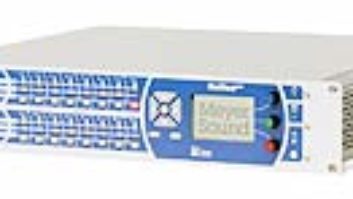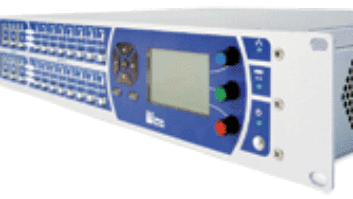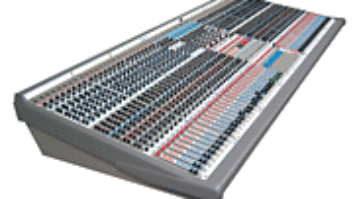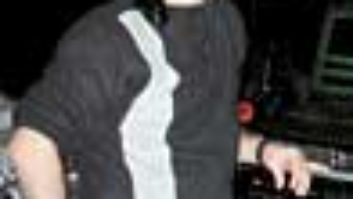The Ashly Protea 4.24G is a rackmount digital equalizer featuring four independent channels of 11/43-octave graphic equalization, plus high and lowpass filters, full-featured limiters and delays on each channel. Its 28 11/43-octave filters are on ISO frequencies from 31 to 16k Hz, allowing 15 dB of cut or boost, with a Q of 3.2. The filters’ behavior and interaction are similar to the analog filters in Ashly’s successful GQX equalizers, from which they were mapped. In addition, the Ashly uses 24-bit, 48kHz delta-sigma A/D converters with 64x oversampling, and at its heart is the 80MHz Motorola DSP56303 processor.
The Protea 4.24G is smartly packaged in a two-rackspace chassis that is less than nine inches deep. (Rear connections include balanced XLR and TRS inputs and outputs.) The front panel features a brightly backlit LCD screen, surrounded by an arrangement of keyboard-style controls: Below the display are 28 pairs of keys for cutting or boosting individual EQ filters; these are also used for adjusting the parameters of the other functions. (For example, pressing both keys associated with a frequency flattens that filter.) As adjustments are made, a corresponding picture of a fader on the display moves up or down.
To the left of the display screen, menu keys page through each channel’s four audio functions, and they provide access to a second page of global parameters that address metering, MIDI, security and user preferences. There are three levels of password-protected security: All Access, Presets Locked and Full Lockout. The metering screen shows the input and output levels of all four channels in dBu. Each channel also has a front-panel bi-color LED to indicate signal at 0 dBu and clipping at +19 dBu. Another LED shows whether that channel is muted, and a third LED on the other side of the channel select indicates the channel being operated. Four Bank keys are used when multiple Protea units are chained together in larger systems, allowing up to 16 channels to be controlled from a master unit or from the remote.
Each of the Protea’s four audio functions can be bypassed individually. The high and lowpass filters are 24 dB per octave, affording a high degree of roll-off and allowing them to serve as crossovers in special situations. The limiter has adjustments for threshold, ratio, attack and release; metering of gain reduction and output level is shown in the display. The delay is adjustable in increments as small as .02 millisecond, with up to 341 milliseconds available, also given in feet and meters. In addition to the obvious applications aligning FOH delay and zone speakers, this delay could also be used to synchronize the arrival from floor monitors with that of the sidefills or even the side lobes of the mains. Though not all the Protea’s audio functions are needed all the time, having them available may occasionally eliminate the need for additional processing and afford additional refinements.
The 4.24RD Remote is nearly identical to the front panel interface and duplicates most of its controls. It communicates using MIDI over a pair of XLR cables and, like the main unit, can control up to 16 channels of processing. It gets its power through the XLR cables, which can run up to 1,000 feet long. I used a 6-conductor shielded Protea cable from Rapco; it travels across the stage and coils better than two mic cables taped together. Because the Protea communicates using the MIDI spec and has MIDI connectors, it can also be controlled using third-party devices; the parameters are available on continuous controllers 1 to 40.
The Protea processors can also be controlled from a PC with Windows95 software that is supplied or can be downloaded from the Ashly Web site (www.ashly.com) for free. Using RS-232, the computer communicates from a serial port to a 9-pin D-connector on the Protea’s rear panel, over a cable that can be up to 50 feet long. Settings can be edited offline, archived on the PC and printed out. Ashly offers two other Protea products-slave units, either 2 or 4 channels (the 2.24GS and the 4.24GS, respectively)-that have the same DSP functionality without front-panel controls and can be controlled from a main unit, the remote or a computer. They provide an economical alternative for building larger multi-unit systems or for installers who don’t want to give full control to operators.
The Protea has 128 presets that can be given names up to ten characters long. Each contains the settings of all four audio functions for a single channel. The Protea also has 50 scenes, with each scene assigning a preset to each of up to 16 channels; a library of presets designed for specific combinations of vocal mics and wedges can allow a monitor engineer to get a rig up and running quickly. I kept these monitor presets in the 30s and 40s locations. The Protea is also useful for FOH applications, so another library for main speakers in locations 50 to 69 was useful. Because there are application overlaps between FOH and monitors for delay speakers and sidefills, having presets for all of a company’s inventory in memory is beneficial. Settings for the P.A. in specific rooms could be kept higher up, in 70 to 100. Locations 101 to 116 were used for specific monitor layouts, allowing presets to be called up, customized and named for individual bandmembers’ mixes. Thus, a scene built from these working settings would immediately recall a snapshot of the stage’s EQ. Presets 121 to 128 or 1 to 16 could be used for the support acts and written to other scenes.
Operating the buttons while watching the screen took a little getting used to, but having the remote’s interface identical to the main unit shortened the learning curve. While it’s not quite as swell as the expensive remote fader heads that other manufacturers offer, for the price of a fancy moving-fader remote you can now buy this entire programmable EQ system. There’s nothing like standing at the mix, talking into the mic and making the adjustments right there. The ability to save all the settings and then turn it over to another engineer is also priceless. And how many times have you been shortchanged on time to properly EQ because of circumstances beyond your control? The benefit of being able to call up an EQ preset confidently is that less barking “one, two, one, two” is required, and you can quickly move on to the next item on the agenda. Did I mention that you can copy the settings of one channel to another with a couple of key strokes?
With the pro net price of the 4.24G at $2,000 and the 4.24GS slave at $1,400, it can be cheaper to put together a Protea system than using Ashly’s GQX analog graphics, and it takes up only a third of the rackspace. A 2-channel system can be created by combining the 2.24GS slave ($950) and the remote ($850), with the remote sliding into a single-space shelf and both units taking up two spaces.
As a system, the Protea offers an affordable, flexible platform solution for a wide range of applications (from installations to touring to one-offs) and can be tailored to the needs of individual users while adding convenience and expertise. The only problem may be having enough inventory so that engineers won’t fight over them. For those who favor parametric EQs over graphics, the folks at Ashly are working on other products, as well.
Ashly Audio Inc., 847 Holt Road, Webster, NY 14580; 716/872-0010; fax 716/872-0739. Web site: www.ashly. com.




